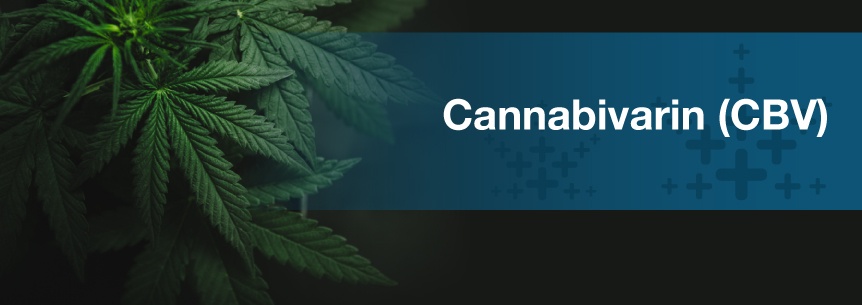
The use of cannabis for private and medicinal application is becoming an increasingly popular topic of discussion throughout governing bodies, health care leaders and the public. As researchers examine the physiological effects of cannabis more intensely, the stigmas tied to marijuana are beginning to fall by the wayside. Instead, more and more people are curious as to how this substance could provide significant potential benefits for adults with varying health conditions. This increased public interest and support has led to marijuana legalization throughout the country.
Many people are quickly becoming familiar with the compound cannabidiol, or CBD. Unlike THC, which is perhaps one of the most commonly known compounds in marijuana, CBD does not make its user high. That allows an individual to use the medicinal properties of the substance without experiencing side effects that may be undesirable. However, CBD is not the only cannabinoid in cannabis. In fact, more than 100 cannabinoids are currently undergoing scientific research. One of these is a phytocannabinoid known as cannabivarin.
Cannabivarin, also interchangeably called cannabivarol or CBV, is the name for the chemical compound C19H22O2. It is a Divarin type and the second most abundant of the cannabinoids in Cannabis sativa. CBV is considered a non-psychoactive cannabinoid — it does not produce euphoric side effects like those, for instance, resulting from THC use. Cannabivarol is hardly present in fresh cannabis and is considered an oxidization product of tetrahydrocannabivarin, also called THCV. CBV also has a similar structure to CBN, or cannabinol, and many other phytocannabinoids.
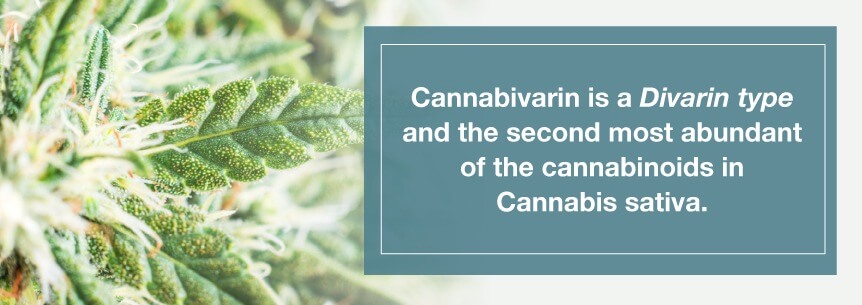
Not unlike other lesser-known cannabinoids, there is still a lack of significant conclusive data about CBV, due to scant research. Cannabivarol is in the phytocannabinoids group, which contains other natural cannabinoids, including cannabigerol and cannabichromene. To determine the potential utility of CBV, we need further research on phytocannabinoids as a whole. Though there is continuous research on the effects of marijuana, and the phytocannabinoid THC specifically, many other cannabinoids in the phytocannabinoid family have yet to be thoroughly studied.
Although scientists have not yet determined how the properties of cannabivarin work individually, the preliminary research seeks to understand how the properties of phytocannabinoids as a whole may impact the body. Phytocannabinoids seem to affect the endocannabinoid system. Endocannabinoids travel to receptors in nearly every part of the human body, impacting each organ and system. These lipids send signals that reach CB1 receptors and influence subsequent synaptic signals.
Plant-derived cannabinoids can mimic the functions of endocannabinoids. Researchers have studied many phytocannabinoids to determine their influence over the brain’s CB1 and CB2 receptors. There’s a possibility phytocannabinoids can stimulate the endocannabinoid system and send targeted signals throughout the body to address health conditions. However, scientists and doctors have yet to determine the effect cannabivarin specifically has on these receptors. Further exploration into its pharmacology needs to occur to deduce whether the properties of CBV act as inhibitors or antagonists of the CB1 and CB2 receptors.
The pharmacology of cannabivarin, including any therapeutic or physiological effects resulting from use, still lacks research. However, studies have examined the potential use of phytocannabinoids in various medical applications. In one experiment, a study concluded cannabidiol could have a chemopreventive effect on colon cancer in mice. Other research suggests phytocannabinoids, specifically CBD and Δ9-THC, may assist in the treatment of psychiatric and mood disorders, Parkinson’s and Alzheimer’s, brain tumors, multiple sclerosis and neuropathic pain. It may also benefit those with lower endocannabinoid counts.
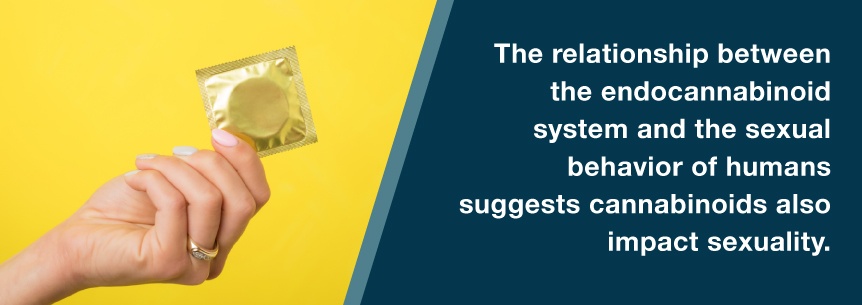
The relationship between the endocannabinoid system and the sexual behavior of humans suggests cannabinoids also impact sexuality. Doctors believe the degree of influence cannabis has over the sexuality of both genders is dose-dependent. Results also vary across a spectrum that includes positive impacts, like increased sexual desire, and negative impacts, like erectile dysfunction in men. Although there is a correlation, more objective research must occur, specifically in determining how THC, CBV, CBD and other cannabinoids impact human sexuality.
Since the relationship between endocannabinoids and cannabinoids exists, there’s a possibility that they could execute similar functions in the body. Regarding appetite control in the treatment of obesity, it appears endocannabinoid receptors, the same receptors influenced by cannabinoids, may impact appetite control, the metabolism and the regulation of body weight. Although researchers anticipate the CB1 receptor systems can influence these aspects of health, more research on endocannabinoids, specific cannabinoids and the endocannabinoid system’s influence over physiology must be studied.
Phytocannabinoids used in moderation may also help individuals who have difficulty sleeping. One study examined the effects of cannabis and cannabinoids on the circadian sleep-wake cycle and specific sleep disorders. It suggests short-term use of cannabis could improve sleep, but long-term use could have the opposite effect. Researchers found cannabinoids, specifically CBD, might be able to mitigate the symptoms of REM behavior disorder in Parkinson’s patients, impact the wakefulness of those who suffer from excessive daytime sleepiness and reduce chronic pain that disrupts sleep quality.
Though the study used animal models, there’s a possibility certain phytocannabinoids may also reduce vomiting and nausea. Delta-9-tetrahydrocannabinol has been studied predominantly and has been medically approved to treat these two symptoms. Other cannabinoids have not received such extensive research. However, one study showed CBD, THCA and THCV could potentially reduce nausea and vomiting — cannabivarin may also have the same effect. Conversely, CBG, another cannabinoid, reverses the effects of CBD and may not be applicable for nausea and vomiting relief.
Currently, two commercially available cannabinoids are approved to help treat cancer-related side effects — nabilone and dronabinol. They are synthetic drugs used to reduce the symptoms of vomiting and nausea in cancer patients who have undergone chemotherapy, and both derive from THC. It will require more research to determine the effects of cannabivarin and other specific phytocannabinoids when used naturally to treat nausea and vomiting symptoms in patients after their chemotherapy sessions.
Phytocannabinoids, specifically THC and CBD, and endocannabinoids seem to have antiproliferative effects on cancer cells. This impact may not be limited to a particular type of cancer, as doctors believe the effect impacts cancer cells throughout the body, including in the thyroid, brain, breast and prostate. A study examined whether these cannabinoids and endocannabinoids could affect ovarian cancer cells. Though the cannabinoids did, the endocannabinoids did not.
Although scientists have identified more than 100 phytocannabinoids, there is still extremely limited knowledge documenting the effects each phytocannabinoid has on the human body. Even research on THC, which is the most prevalent of all phytocannabinoids, is still underway to determine how the compound impacts other systems in the body. It is unknown whether particular dosages of cannabivarin or combinations of CBV and other phytocannabinoids will yield negative side effects.
Using the appropriate resources, scientists can determine the level of cannabivarol in cannabis. However, it is highly unlikely any individual will get screened specifically for cannabivarin use. Instead, it’s more likely a drug screening will determine the level of THC present in an individual. CBV is a natural cannabinoid — THC oxidization converted it into its current state. Using CBV in any fashion will likely result in a positive test for THC, even though CBV is more prevalent than THC.
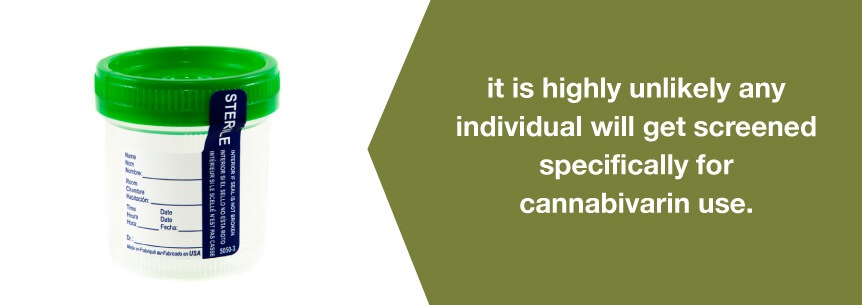
Currently, the U.S. Drug Enforcement Administration considers all forms of cannabis Schedule I drugs. Though this classifies cannabis on a federal level as a substance with no accepted medical use and a high potential for abuse, this does not take into account the laws of individual states which have legalized marijuana for recreational or medicinal use. While some states have now legalized marijuana, it is still illegal for recreational use for those under the age of 21.
The legalities surrounding particular strains derived from cannabis, including cannabivarol, are not acutely defined. Regardless of their unique chemical nature or potential applications, there are two reasons CBV is illegal in a general sense. First, U.S. law classifies all parts of the cannabis plant, seeds and resins, and any compounds, mixtures or derivatives of this plant, as Schedule I drugs. Second, any substance that contains THC is also a Schedule I drug.
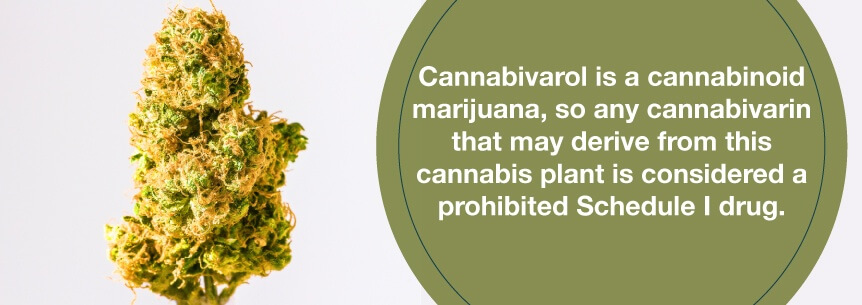
Cannabivarol is a cannabinoid marijuana, so any cannabivarin that may derive from this cannabis plant is considered a prohibited Schedule I drug. If a cannabivarin substance, derived naturally or through synthetic alteration, is found to have any THC in it, it is considered a prohibited substance to possess. For more information about the legalities of cannabivarin and other cannabis substances in your area, speak with a medical marijuana doctor or dispensary staff member.
Though we need to know more about the short- and long-term effects of cannabivarin in medicinal applications, doctors continue to study CBV and dozens of other cannabinoid strains. However, with the limited knowledge we have of CBV and phytocannabinoids in general, it’s difficult to determine exactly which applications would be appropriate for CBV use and whether they’d cause an individual to experience side effects. It will take more research to further identify the practical uses for cannabivarin and the potency in which it would positively impact human health.
Medical marijuana is a recommended treatment option that may help those suffering from a variety of physical and psychological afflictions. More than 80 percent of Americans believe the federal government should legalize marijuana for medical purposes, with more than half agreeing it should also be legal for recreational use. Cannabinoids are merely a few of the hundreds of chemical compounds in marijuana, many of which may provide a wealth of health benefits.
As doctors continue to research new strains of cannabinoids, there’s hope the chemical properties of these naturally occurring compounds will yield positive findings that offer patients the ability to alleviate the symptoms of their health conditions without experiencing debilitating side effects. Until then, physicians prescribe plenty of other medical marijuana alternatives to treat hundreds of health conditions. To learn more and discover how these cannabinoids can benefit your health, speak with a marijuana-trained doctor or dispensary staff member.